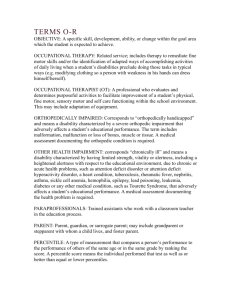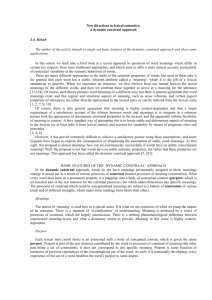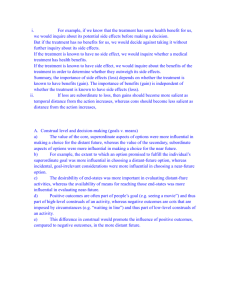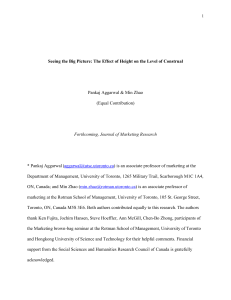Does Bodily Feedback Signal Differential Psychological Distance
advertisement
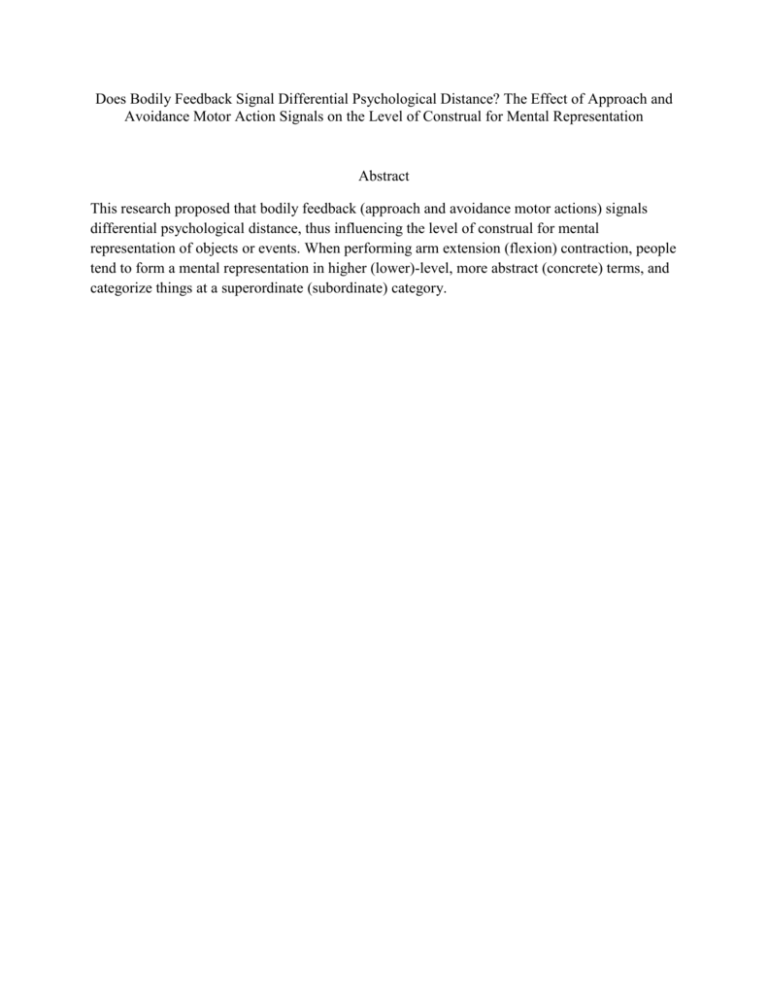
Does Bodily Feedback Signal Differential Psychological Distance? The Effect of Approach and Avoidance Motor Action Signals on the Level of Construal for Mental Representation Abstract This research proposed that bodily feedback (approach and avoidance motor actions) signals differential psychological distance, thus influencing the level of construal for mental representation of objects or events. When performing arm extension (flexion) contraction, people tend to form a mental representation in higher (lower)-level, more abstract (concrete) terms, and categorize things at a superordinate (subordinate) category. Extended Abstract A body of literature has suggested that the chronic-built association between isometric arm flexion/extension contraction and approach/ avoidance motivational orientations influences people’s judgment and attitude formation (Cacioppo, Priester, & Berntson, 1993; Peiester, Cacioppo, & Petty, 1996). Arm flexion (by pressing upward on a table) produces bodily feedback which is associated with approaching positive stimuli; while arm extension (by pressing downward on a table) provides the association with avoiding negative stimuli (Forster, 1998; Forster, & Strack, 1997). This motor action effect is bidirectional. Performing arm flexion vs. extension makes people evaluate a neutral object more positively or negatively; presenting people with positive vs. negative valenced stimuli also automatically activates an approach vs. avoidance motor tendency (Bargh, 1997). Construal level theory was recently suggested by Liberman and Trope (1998) as a framework linking psychological distance and abstraction. According to their theory, the chronic association between psychological distance (temporal, social, spatial or hypothetical) and abstraction in cognition leads to the tendency to mentally represent a distant object with higherlevel (abstract) construals, while represent a near object with lower-level (concrete) construals. We propose that the approach vs. avoidance motor actions, bringing things toward or away from oneself, might signal differential psychological distance. That is, the arm flexion contraction is associated with near psychological distance and arm extension is associated with far psychological distance. Therefore, performing arm flexion might lead to the tendency of construing objects with more concrete, subordinate terms; while performing arm extension leads to a more high-level construal mental representation of objects. Two studies were conducted to test this proposition. In Study 1, participants were presented with a series of pictures of objects from four different categories (vehicle, clothing, furniture, and fruit) on the computers. The choice of exemplars for each category is following Rosch’s (1975) norms, with exemplars having differential typicality to their corresponding categories. The presentation order of the objects was randomized. After seeing each picture, participants were asked to assign the item to a superordinate or a subordinate category (i.e. a picture of apple followed by two categorization choices: apple and fruit). Response time on categorization decision was also measured. While performing the categorization task, participants were asked to either place their palm on the bottom (flexion) or on the top (extension) of the table. We predict that when an objects is presented under arm flexion, less psychological distance of the object is perceived, thus people are more likely to represent it at more concrete construals, which in turn leads to a more subordinate categorization. On the other hand, arm extension will lead to a more superordinate categorization. Repeated measure ANOVA was performed with isometric exercise (flexion vs. extension) as between-subjects variable, and we looked at the isometric exercise effect on both binary categorization choice and response time. Results from the vehicle category support our hypothesis. A significant categorization by motor action interaction effect was shown on the response time (P=.01). When performing arm flexion, people were faster at assigning items to a subordinate category (i.e. car) (RTsuperordinate = 2087; RTsubordinate =1449 mini sec.); while performing arm extension, people were faster at assigning items to a superordinate category (vehicle) (RTsuperordinate =1393 ; RTsubordinate =1567 mini sec.). In Study 2, Vallacher and Wegner’s Behavioral Identification Form (BIF) (1989) was used as the test stimuli to measure the construal level of people’s action identification under different motor action conditions. Specifically, while performing isometric exercise, participants were asked to choose between a high-level and a low-level identity on the 25 action items from the BIF scale (i.e. Reading: a. following lines of print; b. gaining knowledge). The presentation order of the two alternatives was counterbalanced. We predict that people under arm flexion are more likely to choose low-level identity of the actions; while people in the arm extension are more likely to choose high-level identity of the actions. Results of analyses support our prediction (p=.06) Taken these two studies together, we found the effects of bodily feedback on the level of construals being used to represent objects or events. When people are performing arm extension contraction, they tend to form a mental representation in higher-level, more abstract terms, and categorize things at a superordinate category; while performing arm flexion contraction leads to a lower-level, more concrete mental representation and a more subordinate categorization. Previous research has suggested that effect between construal and psychological distance is bidirectional. Manipulations of construal would affect distance perceptions in the same way as the distance of an event influences its construal. Therefore, one of the future research directions will be to test the direct effect of approach/avoidance motor actions on the perception of various dimensions of psychological distance. For example, in the temporal distance dimension, while performing arm flexion vs. extension contraction, participants will be presented with descriptions of a series of events (i.e. imagine that you’re considering “opening a bank account”, “enrolling in a fitness program”), and then be asked to answer how much time from now the activity would be performed (Liberman et al., 2007). It will be interesting to know if people’s perception of psychological distance shifts with the motor actions being performed. Reference Bargh, J. A. (1997), The automaticity of everyday life. In R. S. Wyer Jr. (Ed.), Advances in social cognition (Vol. 10, pp1-61). Mahwah, NJ: Erlbaum. Cacioppo, J. T., Priester, J. R., & Berntson, G. G. (1993), Rudimentary determinants of attitudes: II. Arm flexion and extension have differential effects on attitudes. Journal of Personality and Social Psychology, 65, 5-17. Forster, J., & Strack, F. (1997). Motor actions in retrieval of valenced information: A motor congruence effect. Perceptual and Motor Skills, 85, 1419-1427. Forster, J., & Strack, F. (1998). Motor actions in retrieval of valenced information: II Boundary conditions for motor congruence effects. Perceptual and Motor Skills, 86, 1423-1426. Liberman, N., Macrae, S., Sherman, S. & Trope, Y. (2007). The effect of level of construal on temporal distance. Journal of Experimental Social Psychology, 43, 143–149. Liberman, N., & Trope, Y. (1998). The role of feasibility and desirability considerations in near and distant future decisions: A test of temporal construal theory. Journal of Personality and Social Psychology, 75, 5–18. Priester, J. R., Cacioppo, J. T., & Petty, R. E. (1996). The influence of motor processes on attitude toward novel versus familiar semantic stimuli. Personality and Social Psychology Bulletin, 22, 442-447. Rosch, E., (1975). Cognitive representation of semantic categories, Journal of Experimental Psychology: General, 104, 192-233. Vallacher, R. R., & Wegner, D. M., (1989), Levels of Personal Agency: Individual Variation in Action Identification. Journal of Personality and Social Psychology, 57, 660-671.





